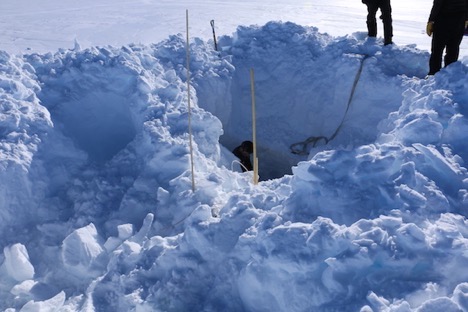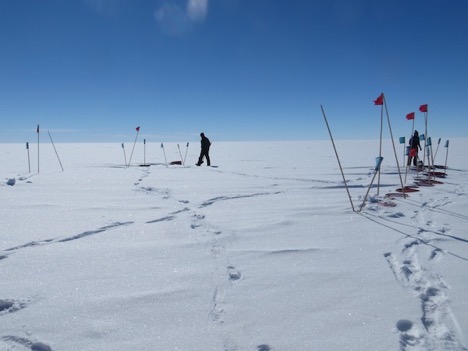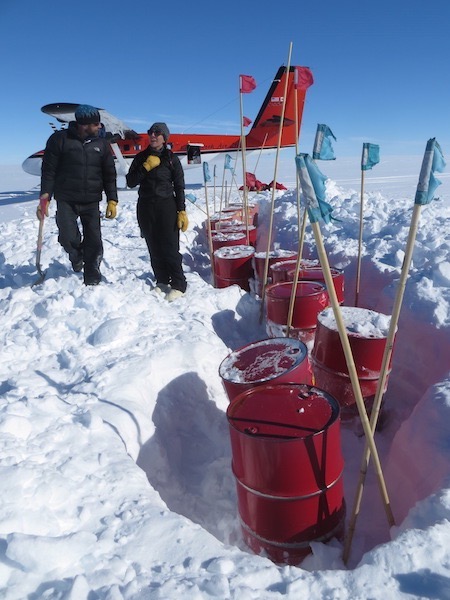In the evening of 5 Jan, another Twin Otter came to camp! This one has the call-sign CKB (the first Otter’s call-sign is KBG), with pilots Phil and Tyson. Given the Twin Otter needs for both our group and POLENET, the flight coordinators must have seen the utility in having two planes here. And indeed it is useful!
But having two planes is only useful when you can fly somewhere. On 6 Jan, weather was bad everywhere but at WAIS, so there was no flying. Since Marian and I finished our work at Kominko-Slade, we were available to help POLENET with their seismic site they have that’s a 20-minute snowmobile ride away from camp. As we had heard and would soon experience, the POLENET sites are WAY more buried than any of our AWS. A total of 8 of us went to the site on 3 snowmobiles. Given the amount of digging and size of their power systems (more than 10 70-pound batteries compared to our 2!), it’s no wonder POLENET brings so many people to the ice.
We had to raise the solar panel tripod (pictured above on the left) and move that to a flat surface. That was buried about 4 to 5 feet. We also had to raise the seismic sensor which was buried around 12 feet. The pile of snow on the right in the picture above is from the deep pit.

The pit, with Austin and Peter (not pictured) deep in it. They weren’t quite yet to the bottom of the sensor.
Helping POLENET out definitely made the digging at our sites seem like nothing comparatively. So that was a positive thing we got out of this trip! A new sense of perspective… Marian and I left once the digging was complete and our services were no longer needed. POLENET successfully raised this site, so they have that going for them, which is nice.
After a day of rest on Sunday, 7 Jan, we were canceled on 8 Jan for our Otter missions to any of our AWS sites due to weather. There is a fuel cache, Turn 1, about an hour’s flight away at which the fuel drums needed to be raised to the surface. Since Marian and I weren’t doing anything else, we offered to fly with CKB to help them dig it out. Terry and Alex from POLENET also came along.
The weather at WAIS was cloudy and dreary, but it was nice and sunny at Turn 1. The wind, however, was fairly strong at around 15 knots when we arrived and only increased throughout our stay. There were 32 drums full of fuel that we were tasked with digging out.
Since the fuel drums are full of fuel, each one weighed about 450 pounds. Our plan was to try to dig them completely out on one side of the drum and then try to have a sort of ramp up to the surface on the other side. Then we would try to yank it up with the help of a couple cargo straps.
Once we were in agreement on our plan of action, the six of us (Marian, Terry, Alex, Phil, Tyson, and myself) began digging. Where else to start?
Once we dug out the first line of drums, we cleared the snow off the surface (to the left of the drums in the picture) so we had a good area to place the drums. Then we all assumed our positions to pull the first drum out. Alex and I were in the pit to help push the drum up. Phil and Tyson each had a cargo strap, which Alex and I secured around the fuel drum. Marian and Terry each took the end of the cargo strap and helped Phil and Tyson pull on the fuel drum. We weren’t sure how well it would work, but much to our delight, it worked beautifully. It only took a couple pulls/heaves to get each drum to the surface.
We all took a break after the first line of drums. The second line of drums was a little bit more intense because the wind had increased, and blowing snow became a nuisance. Regardless, we got those drums up and finished our work in a couple hours. It was a good workout and pretty satisfying to raise them. They probably have a couple years where they can be neglected before they will need to be raised again… which is representative of just about all field work in Antarctica.
Cheers,
Dave Mikolajczyk








